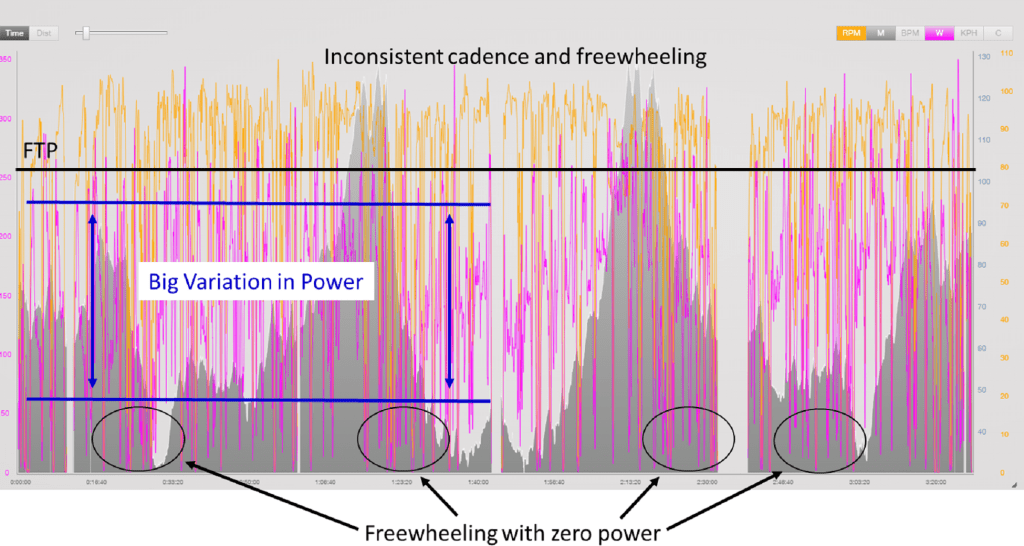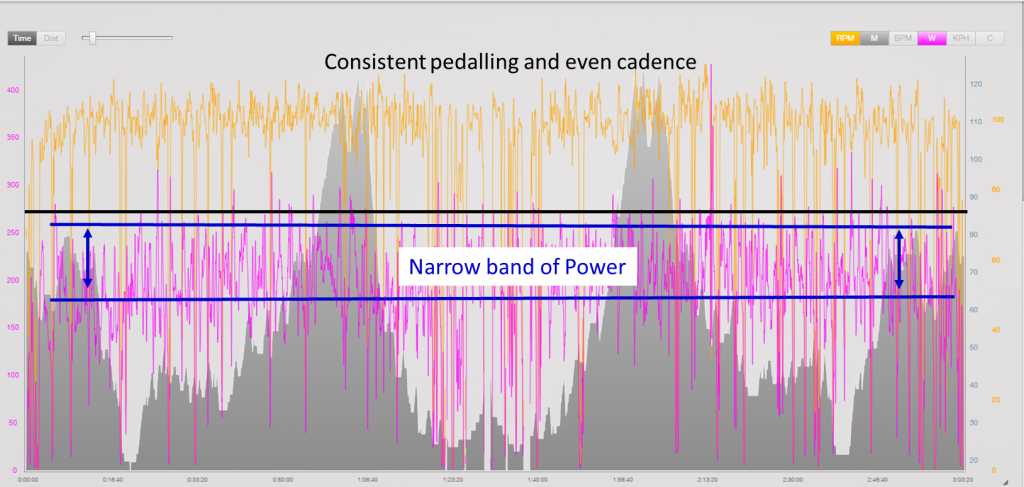Power Meters are a powerful tool for racing and training, helping you on improving cycling technique. A key objective in training with a Power meter is increasing Functional Threshold Power (FTP – greatest power a rider can sustain for 60 minutes). However, as important is the ability to ride more efficiently through improved cycling behaviour. Training with a power meter can help achieve this.
Improving cycling behaviours such as
 Normalised Power: 173W (69% of FTP) Cadence avg: 86rpm Variability: 1.23
Variability represents the variance in power for a ride, the closer to 1.00 the better representation of riding with even power.
The jerky nature of Power (pink) shows big variations in Power coupled with inefficient pedalling. Additionally, there are numerous sections of coasting or freewheeling (not pedalling) where Power is at or close to 0 (link at the bottom of the chart).
Normalised Power: 173W (69% of FTP) Cadence avg: 86rpm Variability: 1.23
Variability represents the variance in power for a ride, the closer to 1.00 the better representation of riding with even power.
The jerky nature of Power (pink) shows big variations in Power coupled with inefficient pedalling. Additionally, there are numerous sections of coasting or freewheeling (not pedalling) where Power is at or close to 0 (link at the bottom of the chart).
 Normalised Power: 199W (72% of FTP) Cadence avg: 99rpm Variability: 1.08
Similar overall Intensity as Figure 1, however very different in behaviour producing a much more consistent and efficient ride.
A very thin range of power throughout the entire ride, and controlling the effort with changes in elevation (grey) especially on hills.
Training with Power isn’t just about increasing your FTP. Improving cycling efficiency and technique utilising power can additionally produce an improved performance in racing, for recovery, and being in an appropriate condition for subsequent training sessions.
For more on our training services, you can check out our Triathlon Squad, Powercycle Studio, Swim Squad and Stroke Correction and Junior Triathlon Squad pages.
Normalised Power: 199W (72% of FTP) Cadence avg: 99rpm Variability: 1.08
Similar overall Intensity as Figure 1, however very different in behaviour producing a much more consistent and efficient ride.
A very thin range of power throughout the entire ride, and controlling the effort with changes in elevation (grey) especially on hills.
Training with Power isn’t just about increasing your FTP. Improving cycling efficiency and technique utilising power can additionally produce an improved performance in racing, for recovery, and being in an appropriate condition for subsequent training sessions.
For more on our training services, you can check out our Triathlon Squad, Powercycle Studio, Swim Squad and Stroke Correction and Junior Triathlon Squad pages.
- how hard or how easy you ride (measured by Power),
- how you ride on hills and the downhills
- when and where you are changing gears influence your Power and efficiency
- pedalling with a consistent cadence and constant pedalling assist in riding within a narrow band of power
Maintaining a relatively even power range at an appropriate level for the type of ride you are undertaking is the key to improved cycling efficiency. An aerobic ride @ 70-75% of FTP. Staying within this power range for flat riding, rolling hills, minor climbs and minor descents is what you should be aiming to achieve.Your cadence also impacts cycling efficiency. Changing gears at appropriate times when riding, such as early on a climb to maintain your cadence and power. And maintaining the same power on flatter sections and minor descents additionally assist in maintaining an even power range.
Let’s Compare Cycling behaviour
Figure 1
 Normalised Power: 173W (69% of FTP) Cadence avg: 86rpm Variability: 1.23
Variability represents the variance in power for a ride, the closer to 1.00 the better representation of riding with even power.
The jerky nature of Power (pink) shows big variations in Power coupled with inefficient pedalling. Additionally, there are numerous sections of coasting or freewheeling (not pedalling) where Power is at or close to 0 (link at the bottom of the chart).
Normalised Power: 173W (69% of FTP) Cadence avg: 86rpm Variability: 1.23
Variability represents the variance in power for a ride, the closer to 1.00 the better representation of riding with even power.
The jerky nature of Power (pink) shows big variations in Power coupled with inefficient pedalling. Additionally, there are numerous sections of coasting or freewheeling (not pedalling) where Power is at or close to 0 (link at the bottom of the chart).
Figure 2
 Normalised Power: 199W (72% of FTP) Cadence avg: 99rpm Variability: 1.08
Similar overall Intensity as Figure 1, however very different in behaviour producing a much more consistent and efficient ride.
A very thin range of power throughout the entire ride, and controlling the effort with changes in elevation (grey) especially on hills.
Training with Power isn’t just about increasing your FTP. Improving cycling efficiency and technique utilising power can additionally produce an improved performance in racing, for recovery, and being in an appropriate condition for subsequent training sessions.
For more on our training services, you can check out our Triathlon Squad, Powercycle Studio, Swim Squad and Stroke Correction and Junior Triathlon Squad pages.
Normalised Power: 199W (72% of FTP) Cadence avg: 99rpm Variability: 1.08
Similar overall Intensity as Figure 1, however very different in behaviour producing a much more consistent and efficient ride.
A very thin range of power throughout the entire ride, and controlling the effort with changes in elevation (grey) especially on hills.
Training with Power isn’t just about increasing your FTP. Improving cycling efficiency and technique utilising power can additionally produce an improved performance in racing, for recovery, and being in an appropriate condition for subsequent training sessions.
For more on our training services, you can check out our Triathlon Squad, Powercycle Studio, Swim Squad and Stroke Correction and Junior Triathlon Squad pages. 

